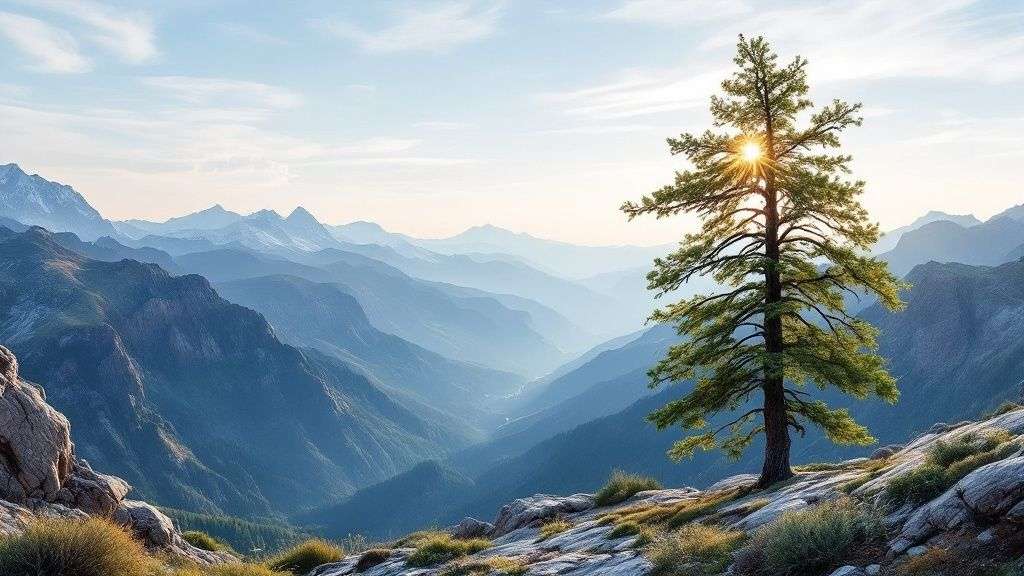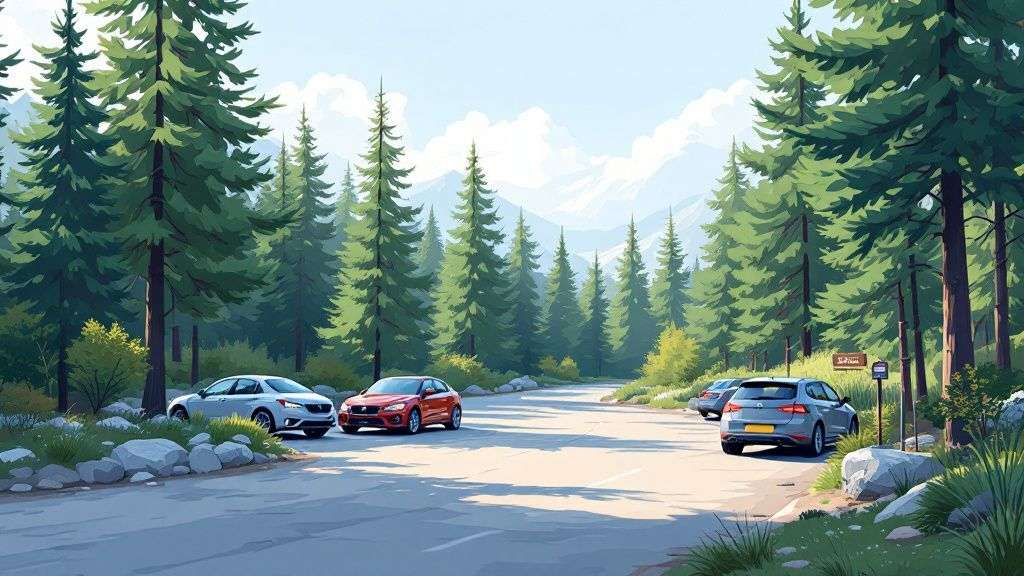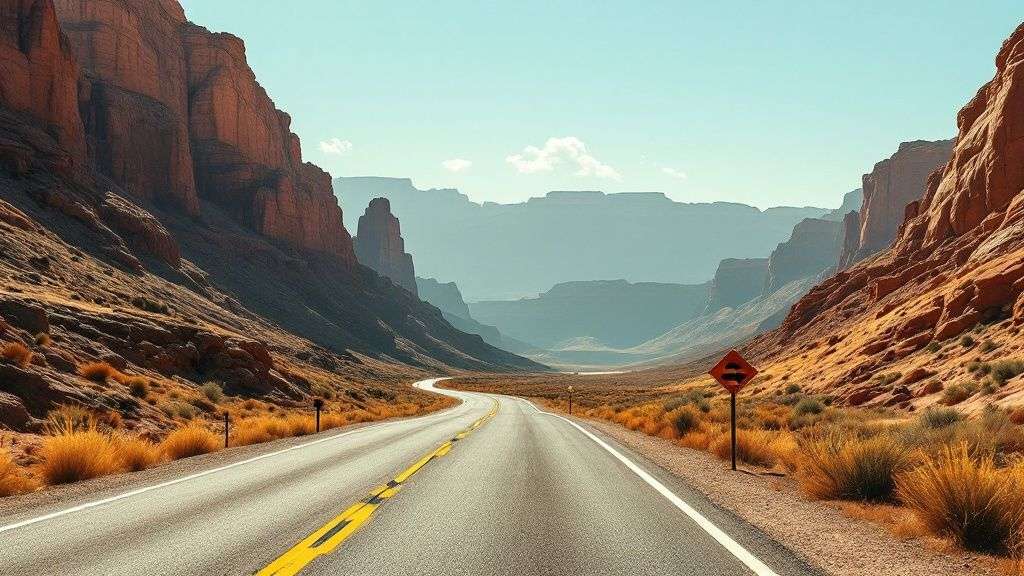How to Beat Little Cottonwood Canyon Traffic
Beat Little Cottonwood Canyon traffic with our guide to the best travel times, real-time UDOT updates, and winter driving tips. Spend less time in the car.
Navigating Little Cottonwood Canyon traffic can feel like a gamble, but the congestion follows a predictable pattern. To avoid the infamous "red snake," aim to be at the canyon mouth before 7:00 AM on weekends or after 1:00 PM for an afternoon ski. This guide provides actionable, local tips on what causes the gridlock, when to travel, and how to use real-time data to plan a stress-free trip.

What Causes Little Cottonwood Canyon Traffic?
Little Cottonwood Canyon traffic grinds to a halt from a combination of high vehicle volume, severe weather, and road incidents. State Route 210 is the only road to Alta and Snowbird, creating a massive funnel effect, especially on powder days. This chokepoint is made worse by heavy snow, necessary avalanche control work, and accidents often caused by drivers unprepared for steep, slick mountain roads.
High Vehicle Volume
At its core, the gridlock is a simple math problem: thousands of cars trying to use a two-lane road at the same time. The magnetic pull of two world-class resorts, Alta and Snowbird, creates a massive uphill surge in the morning and a downhill rush in the afternoon that overwhelms SR-210.
This is what creates the infamous "red snake"—that endless, winding line of taillights snaking up the canyon. With no other way in or out, every vehicle adds to the problem. A single slow driver or a minor fender-bender can trigger a ripple effect, bringing traffic to a standstill.
Think of SR-210 as a funnel. When too many cars try to pour in at once—especially between 7:00 AM and 9:30 AM—the whole system backs up. A drive that should take 20 minutes can easily turn into a multi-hour ordeal.
Severe Weather and Avalanche Control
Little Cottonwood is legendary for "The Greatest Snow on Earth®," but that blessing is also a major contributor to the traffic curse. Heavy snow reduces visibility and makes an already steep, winding road incredibly treacherous.
To keep everyone safe, the Utah Department of Transportation (UDOT) frequently closes the road for avalanche mitigation. Crews use explosives to trigger small, controlled slides to prevent much larger, dangerous natural avalanches. This work is essential for safety but leads to significant, often unpredictable, road closures. On a busy day, this can easily turn a typical 21-minute drive into a 45-minute slog or worse, according to UDOT's transportation analysis from the environmental impact study.
Road Incidents and Lack of Preparation
The final piece of the puzzle is driver preparedness—or the lack thereof. A significant number of accidents and slowdowns are caused by vehicles that aren't equipped for winter mountain driving. When UDOT's traction law is in effect, specific tires or chains are required by law.
Unfortunately, unprepared drivers often spin out, get stuck, or cause accidents, blocking the only lane of travel. Each incident can stop traffic dead in its tracks, compounding the congestion from high volume and bad weather. For a detailed breakdown of the rules, see our Little Cottonwood Canyon winter driving guide.
When is the Best Time to Drive Little Cottonwood Canyon?
Timing is everything. Understanding the daily ebb and flow of cars is your single greatest advantage for dodging delays. By planning your drive around predictable peak hours, you can turn a frustrating crawl into a smooth, scenic journey to the slopes.

Best and Worst Times for Uphill Travel
The morning uphill migration is the source of the worst gridlock. On a typical weekend or holiday, the heaviest traffic jams build between 7:00 AM and 9:30 AM. On powder days, backups can form as early as 6:00 AM.
Your Best Uphill Travel Windows:
- The Early Bird (Before 7:00 AM): Arriving at the canyon mouth before 7:00 AM on weekends is the most reliable way to beat the crowds and secure a good parking spot.
- The Afternoon Arrival (After 1:00 PM): Uphill traffic clears out almost completely after the morning rush. This is a great option for a half-day on the mountain.
Local Tip: Weekdays (Monday through Thursday, non-holidays) offer far more flexibility. While there's still a mini-rush around 8:30 AM, it's nothing compared to the weekend chaos.
Best and Worst Times for Downhill Travel
Just as the morning has its uphill battle, the afternoon has a predictable downhill surge. This typically hits between 3:00 PM and 5:30 PM, as skiers and snowboarders leave the resorts en masse.
To sidestep this, you have two solid strategies:
- Leave Early: Get on the road before 2:30 PM to stay ahead of the main departure wave.
- Stay Late: Enjoy another hour on the slopes or grab some food at the base. Leaving after 6:00 PM almost always guarantees a clear road down.
How to Check Little Cottonwood Canyon Traffic in Real-Time
You don't have to leave your drive to chance. A few key digital tools provide live intel on road conditions, allowing you to make smart, last-minute decisions that can save you hours of frustration. Always check the real-time Little Cottonwood Canyon conditions before you leave.

Use the UDOT Traffic App
The official UDOT Traffic app is your mission control for SR-210. It provides a live dashboard showing exactly what’s happening in the canyon right now. You can view live camera feeds to see traffic with your own eyes, check for road closures, and get instant alerts when the traction law goes into effect.

Local Tip: I check the app 15-30 minutes before I plan to leave. If traffic is already backing up past the mouth of the canyon, I'll delay my trip or hop on the UTA Ski Bus instead.
Follow @UDOTCottonwoods on X (Twitter)
For the absolute latest, up-to-the-second information, following @UDOTCottonwoods on X (formerly Twitter) is a must. This is where UDOT’s team posts real-time updates directly from the crews on the ground. You'll get instant alerts for avalanche control work, accidents, and traction law status changes. Pairing the visual overview from the app with instant alerts from X gives you the most complete picture of the road.
How to Avoid Driving in Little Cottonwood Canyon
The single best way to beat Little Cottonwood Canyon traffic is to not be a part of it. Using public transit or carpooling not only saves you a headache but also helps reduce overall congestion for everyone.
Ride the UTA Ski Bus
The Utah Transit Authority (UTA) Ski Bus is a local's secret weapon. It’s affordable, reliable, and equipped for mountain travel. When traction laws are in effect, these buses are often the only vehicles moving smoothly up the canyon.
For Alta and Snowbird, look for Route 994, which services Park & Ride lots at the Historic Sandy TRAX Station and at 9400 South & 2000 East.
The bus is a great value. A one-way fare is just $5, and if you have an Ikon or Mountain Collective pass, your ride is often free—just scan your pass when you board.
Carpool or Take a Shuttle
Carpooling is a simple but powerful way to reduce traffic. The resorts incentivize this by offering premium parking spots to cars with 3 or 4+ people. For a more seamless trip, private shuttles offer door-to-door service from hotels or airport rentals, eliminating the stress of winter driving and parking altogether.
Little Cottonwood Canyon Traffic FAQ
How early should I leave for a weekend powder day?
To be parked and ready for first chair, aim to be at the mouth of Little Cottonwood Canyon by 7:00 AM. On an epic powder day or holiday weekend, push that up to 6:30 AM. The worst traffic typically builds between 7:30 AM and 9:30 AM.
What is an "avalanche control" closure?
This is a critical safety operation where UDOT crews intentionally trigger small, manageable avalanches to prevent a much larger, dangerous natural slide from hitting the road. These closures are most common in the early morning but can happen anytime conditions are hazardous. Check @UDOTCottonwoods on X for real-time updates.
Can I take an Uber or Lyft to Alta or Snowbird?
It's risky. On a clear day, you can usually find a ride. However, when a storm hits and the traction law is active, most rideshare vehicles are not properly equipped with 4WD/AWD and snow tires, leading to frequent cancellations. For a guaranteed ride on a snowy day, the UTA Ski Bus or a dedicated canyon shuttle is your most reliable option.
For more answers to common questions, visit our complete Wasatch Roads FAQ page.